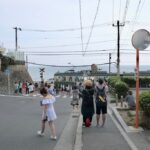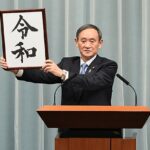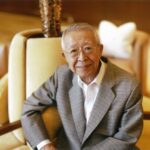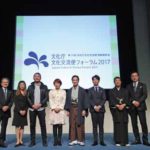On 26 January 2017, the representatives of four haiku organizations and local governments held a press conference at the Japan National Press Club in Chiyoda Ward, Tokyo, and announced that they would launch a Promotion Council on April 24 targeting the designation of haiku on UNESCO’s list of Intangible Cultural Heritage of Humanity. Among the presenters were Arima Akito (president of the Haiku International Association), Takaha Shugyo (president of the Association of Haiku Poets), Inahata Teiko (president of the Association of Japanese Classical Haiku), Miyasaka Shizuo (president of the Gendai Haiku Association) and Mayor Okamoto Sakae of Iga, Mie Prefecture, the birthplace of Matsuo Basho. The group has been working on the project since July 2016.

From left, Okamoto Sakae (Mayor of Iga City), Takaha Shugyo (president of the Association of Haiku Poets), Arima Akito (president of the Haiku International Association), Inahata Teiko (president of the Association of Japanese Classical Haiku), and Miyasaka Shizuo (president of the Gendai Haiku Association)
“Haiku is the world’s shortest fixed form of poetry composed of syllables arranged in a five-seven-five pattern. Haiku is a form of literature that expresses human beings coexisting with nature. The fact that many Japanese people read and compose haiku is one of the reasons for our push for the designation of haiku as a UNESCO intangible cultural heritage of Humanity,” said Arima.
Arima commented that the perspective of haiku was based on loving nature and treating nature with great care and attention. He said that haiku would help to nurture the hearts of people by considering the global natural environment and stressed the significance of disseminating this perspective to indirectly share an interest in the issue of global warming.
Okamoto expressed his determination, saying, “Haiku is a form of literature that Japan offers to the world. I believe that we are responsible for spreading it globally as residents of the birthplace of Matsuo Basho. We have a strong support structure both at home and abroad, such as Herman Van Rompuy, President Emeritus of the European Council and Haiku Ambassador for Japan-EU Friendship, as well as the people belonging to the four related organizations. We hope to turn our campaign to designate haiku on UNESCO’s list of Intangible Cultural Heritage of Humanity into a national movement and further expand this worldwide.”
These people will launch the Promotion Council and cooperate with twenty-two local governments that are associated with haiku to promote the campaign.
The most significant characteristic of haiku is its brevity. Haiku is a form of literature that everyone can create easily. It is so accessible that it attracts many devotees and admirers from around the world. Six to seven million haiku lovers are said to exist in Japan and approximately 200,000 people enjoy producing haiku in their native languages in about fifty countries and regions.
Arima expressed his expectations, “People can communicate with each other by producing haiku, which will lead to the realization of world peace.” Takaha pointed out the attractiveness of haiku and said, “Haiku, through which the authors express their feelings in the shortest form, is also suitable for the rhythm of people who live in our busy contemporary society that is rapidly changing. Each haiku leaves room for multiple interpretations. The way people interpret and enjoy reading haiku changes with the different reading patterns and different ages.” Inahata said, “People produce haiku by looking with great care and attention at nature. It will be wonderful if this spirit of expressing hope for peace spreads all around the world.” Miyasaka stressed the significance and value of pushing for the designation of haiku as intangible cultural heritage and said, “Haiku expresses life through words. I want to disseminate the Japanese way of living in turbulent times to the world through haiku.”
The Birth of Haiku

This print by ukiyo-e master Tsukioka Yoshitoshi depicts the hokku poet Matsuo Basho meeting two farmers celebrating the mid-autumn moon festival. The haiku in the white box at the top right of the print reads, “Since the crescent moon, I have been waiting for tonight.”
One major form of traditional Japanese poetry is tanka, which consists of thirty-one syllables arranged in a five-seven-five-sevens even pattern. Influenced by the poems that were introduced from China, Japanese people began to produce tanka to express their emotions. Major tanka collections include the Man’yoshu, which was compiled from the late seventh to late eighth century, and the Shinkokinwakashu, which was compiled in the late twelfth century. Even today many people enjoy producing tanka. The numerous collections of tanka were compiled by imperial order, but the creators whose works were selected for the collections ranged from court aristocrats to ordinary people. Utakai hajime, the Imperial New Year’s Poetry Reading held in January every year, is based on this tradition to showcase excellent poems selected from ordinary people as well as Imperial family members. This is the origin of Japan’s long tradition of governing based on poetry.
After the twelfth century, the verse that emerged, inspiring gatherings of many people, was waka, thirty-one-syllable Japanese poems. In the Edo period (1603–1867), people experienced the birth of this popular linked verse that introduced playful minds to a new concept. In popular linked verse, people enjoy linking the first hokku (five-seven-five) to renku (seven-seven) in a poem.
It was Matsuo Basho that added artistic value to popular linked verse. Basho produced many hokku, which became the origin of haiku. Masaoka Shiki perfected the literature of haiku by making hokku independent in the Meiji period (1868–1912). Shiki, who was born in Matsuyama, Ehime Prefecture, studied at the University of Tokyo and created popular linked verse. Most haiku producers today are Shiki’s students or belong to the school of Shiki. Novelist Natsume Soseki produced many haiku with the help of Shiki’s teaching.
Haiku Lovers Overseas
Herman Van Rompuy (see page 4 of this issue), President Emeritus of the European Council, is a well known haiku poet who has published two collections of haiku poems. Van Rompuy also serves as the Haiku Ambassador for Japan-EU Friendship, a two-year position to which he was appointed in June 2015 by Foreign Minister Kishida Fumio. The reason for Van Rompuy’s appointment to the role is that he has been contributing to the promotion of understanding of Japanese culture through haiku. At the induction ceremony, Kishida presented a haiku.
Nichio no 日欧の
shinko hiromu 親交ひろむ
kunpu ya 薫風や
(Japan-Europe friendship, ever boundlessly growing, in the fresh summer breeze.

Herman Van Rompuy speaks at the Symposium on
Cultural Exchanges through Haiku between
Europe and Japan, 1 June 2015.
Van Rompuy presented two of his own haiku on the same occasion.
On the green mountains
the woods in light and shadow
Fertile haiku ground
All over the world
Poets sing life and nature
Sharing makes peace
Lars Vargö, the Ambassador of Sweden to Japan, is another well known haiku poet. At the 14th General Meeting and Lecture of the Haiku International Association (HIA) held in November 2012, Vargö said that many leading poets during the peaceful period of Sweden have been influenced by haiku poetry, including Harry Martinson (1904–1978), who won the Nobel Prize in Literature in 1974, and Dag Hammarskjöld (1905–1961), who served as the second Secretary-General of the United Nations. A collection of his haiku was published in 1963 under the title Vägmärken (Markings).
The Ambassador mentioned a Snow in April, published in 2000, which selected 100 haiku each from Sweden and Japan. This collection includes a haiku by Tomas Tranströmer, winner of the 2011 Nobel Prize in Literature. Ambassador Vargö introduced Tranströmer’s famous haiku found in The Sorrow Gondola, his magnum opus.
The power lines
stretched across the kingdom
of frost
north of all music
Another haiku enthusiast is Radu Şerban, Ambas sador of Romania to Japan.
He delivered a speech at the 14th General Meeting and Lecture of HIA held in December 2015. He mentioned the Romanian short poetry “doina,” already listed on the UNESCO intangible Cultural heritage of Humanity in 2009. He said, “I see many other similarities between the aesthetics of “doina” and haiku, both being so much inspired by nature, seasons, weather, state of spirit, and so on.” Doina is described on the UNESCO site as a “lyrical, solemn chant, improvised and spontaneous.”
The haiku lover introduced a haiku by another Romanian haiku poet, which won a European contest in 2010:
Unfolding a map
the cherry petals connect
Europe and Japan
He introduced more Romanian poets who wrote many haiku including a famous poet, Nichita Stănescu (1933–1983), who was a candidate for the Nobel Prize in Literature:
The fog
wraps in itself the new born
of the light
At the press conference, the haiku professionals from four related organizations spoke about the challenges to the designation of haiku as a UNESCO Intangible Cultural Heritage of Humanity. For example, the importance of global promotional activities, such as the choice and translation of haiku that will be instructive for potential haiku aficionados and efforts to disseminate them to the world. The challenges also include a survey of overseas situations surrounding haiku. In addition, love affairs and thoughts are the subjects of three-line poems, but haiku express things about nature. Explaining the difference between haiku and three-line poems is difficult. The campaign for designating haiku as a UNESCO Intangible Cultural Heritage of Humanity has just started. There will be many more obstacles to overcome in the future.
Finally, Arima said, “The power of Japan as a whole is important. Mount Fuji and Japanese cuisine were also actively supported by ordinary citizens and related people. We need support from the entire nation beyond the Promotion Council that will launch.”
It is also important to expand the circle of domestic haiku lovers.
Translated from an original article in Japanese written for Discuss Japan. [February 2017]












